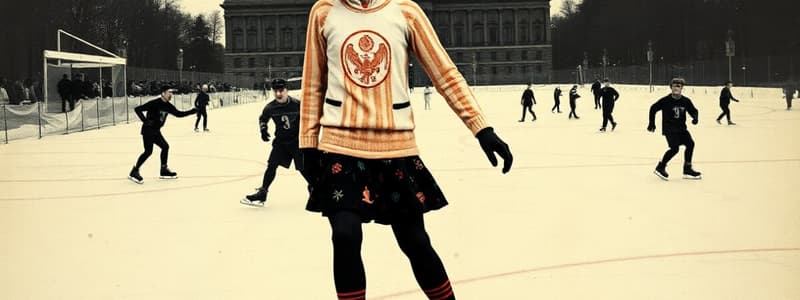Podcast
Questions and Answers
What is the primary function of ice skates?
What is the primary function of ice skates?
- To assist in underwater activities
- To provide warmth in cold environments
- To increase friction on slippery surfaces
- To enable gliding on ice (correct)
Around what time period does the earliest evidence of skating date back to?
Around what time period does the earliest evidence of skating date back to?
- 1000 AD
- 1892 AD
- 3000 BC (correct)
- 1742 AD
What material were the earliest skates made of?
What material were the earliest skates made of?
- Steel
- Animal bones (correct)
- Wood
- Iron
Which country significantly improved skate design in the 13th and 14th centuries?
Which country significantly improved skate design in the 13th and 14th centuries?
What is the name of the first skating club?
What is the name of the first skating club?
In what year was the International Skating Union (ISU) founded?
In what year was the International Skating Union (ISU) founded?
Which of these sports is a discipline within figure skating that emphasizes rhythm and footwork?
Which of these sports is a discipline within figure skating that emphasizes rhythm and footwork?
Which type of ice skate typically has a longer, curved blade with toe picks?
Which type of ice skate typically has a longer, curved blade with toe picks?
What is the purpose of the hollow ground on ice skate blades?
What is the purpose of the hollow ground on ice skate blades?
Which machine is used to resurface ice rinks?
Which machine is used to resurface ice rinks?
What is the term for maintaining momentum on one or both skates with minimal effort?
What is the term for maintaining momentum on one or both skates with minimal effort?
Which basic skating technique uses the edges of the blades to change direction?
Which basic skating technique uses the edges of the blades to change direction?
What should a skater do to fall safely?
What should a skater do to fall safely?
In figure skating, what are jumps primarily judged on?
In figure skating, what are jumps primarily judged on?
Which of the following is a common element in pairs skating where one partner lifts the other overhead?
Which of the following is a common element in pairs skating where one partner lifts the other overhead?
What are the two main components that judging is based on in competitive ice skating?
What are the two main components that judging is based on in competitive ice skating?
What does the ISU Judging System (IJS) assign points for?
What does the ISU Judging System (IJS) assign points for?
Which of the following is a health benefit of ice skating?
Which of the following is a health benefit of ice skating?
Wearing what type of gear reduces the risk of serious injury while ice skating?
Wearing what type of gear reduces the risk of serious injury while ice skating?
What is an important safety measure to consider to avoid collisions and maintain a safe environment?
What is an important safety measure to consider to avoid collisions and maintain a safe environment?
Flashcards
Ice Skating
Ice Skating
Gliding on ice using ice skates as a recreational and competitive sport.
Early Skates
Early Skates
Animal bones used for skating, dating back to 3000 BC.
Netherlands Skating History
Netherlands Skating History
A country where early skates gained popularity due to its canal-filled landscape.
Skating Club of Edinburgh
Skating Club of Edinburgh
Signup and view all the flashcards
Figure Skating
Figure Skating
Signup and view all the flashcards
Speed Skating
Speed Skating
Signup and view all the flashcards
Ice Hockey
Ice Hockey
Signup and view all the flashcards
Ice Dancing
Ice Dancing
Signup and view all the flashcards
Synchronized Skating
Synchronized Skating
Signup and view all the flashcards
Ice Skates
Ice Skates
Signup and view all the flashcards
Skate Blades
Skate Blades
Signup and view all the flashcards
Hockey Skates
Hockey Skates
Signup and view all the flashcards
Zambonis
Zambonis
Signup and view all the flashcards
Pushing (Skating)
Pushing (Skating)
Signup and view all the flashcards
Gliding (Skating)
Gliding (Skating)
Signup and view all the flashcards
Snowplow Stop
Snowplow Stop
Signup and view all the flashcards
Skate Edges
Skate Edges
Signup and view all the flashcards
Figure Skating Jumps
Figure Skating Jumps
Signup and view all the flashcards
Figure Skating Spins
Figure Skating Spins
Signup and view all the flashcards
Step Sequences
Step Sequences
Signup and view all the flashcards
Study Notes
- Ice skating is a recreational and competitive sport involving gliding on ice using ice skates.
History
- The earliest evidence of skating dates back to about 3000 BC, found near the Southern Bug River in Ukraine. These were made of animal bones, typically from horses, oxen, or reindeer.
- Skating emerged as a means of transportation in Scandinavia around 1000 AD.
- Early skates were fastened to the feet using leather straps.
- The Dutch improved skate design by introducing a wooden platform attached to a flattened iron bottom in the 13th and 14th centuries
- This development made skating more efficient and popular, especially in the Netherlands' canal-filled landscape.
- Skating evolved into a recreational activity during the 17th century, with the nobility and upper classes embracing it.
- The Skating Club of Edinburgh, formed in 1742, is recognized as the first skating club.
- Early skate blades were attached directly to boots, and by the mid-19th century, steel blades were developed, enhancing speed and maneuverability.
- Figure skating gained prominence in the mid-19th century, with American Jackson Haines pioneering a more artistic and free-flowing style.
- The International Skating Union (ISU) was founded in 1892, standardizing rules and promoting international competitions.
- Ice skating was included in the Summer Olympics in 1908 (figure skating) and the Winter Olympics in 1924 (speed skating).
Types of Ice Skating
- Figure skating involves performing jumps, spins, and other intricate moves on the ice.
- Speed skating is a competitive sport where participants race against each other over various distances.
- Ice hockey is a team sport played on ice, involving skating, puck handling, and shooting.
- Ice dancing is a discipline within figure skating that emphasizes rhythm, interpretation, and precise footwork.
- Synchronized skating involves teams of skaters performing intricate formations and maneuvers in unison.
- Bandy is a team sport played on a large ice surface, similar to field hockey but with skates.
- Ice stock sport is a sport similar to curling, played on ice with teams sliding ice stocks towards a target.
- Ringette is a team sport played on ice, primarily by women, using a straight stick to pass a rubber ring.
Equipment
- Ice skates are specialized boots with blades attached to the bottom, enabling skaters to glide on ice.
- Blades are typically made of hardened steel, with a hollow ground along the length to provide edges for grip and control.
- Figure skates have longer, curved blades with toe picks for performing jumps.
- Hockey skates are more rigid and offer greater ankle support, with a shorter, less curved blade.
- Speed skates have long, straight blades that are hinged at the front, allowing for greater speed and efficiency.
- Protective gear includes helmets, gloves, knee pads, and elbow pads to prevent injuries from falls or collisions.
- Specific sports may require additional protective equipment, such as face masks in ice hockey.
- Skating attire includes clothing that allows for freedom of movement and insulation against the cold.
Ice Rinks
- Indoor ice rinks provide a controlled environment for skating, with artificial refrigeration maintaining a consistent ice surface.
- Outdoor ice rinks can be natural bodies of water that freeze in cold weather or artificial rinks set up temporarily.
- Ice rinks require regular maintenance, including resurfacing to remove imperfections and ensure a smooth skating surface.
- Zambonis are specialized machines used to resurface ice rinks by shaving the ice, removing debris, and laying down a fresh layer of water.
Basic Skating Techniques
- Balancing is fundamental to ice skating, requiring a centered stance and controlled movements.
- Pushing involves using the inside or outside edge of the blade to propel oneself forward.
- Gliding is the act of maintaining momentum on one or both skates with minimal effort.
- Turning is achieved by shifting weight and using the edges of the blades to change direction.
- Stopping can be done using various techniques, such as the snowplow stop or T-stop.
- Edges are the inside and outside curves of the blade that provide grip and control on the ice.
- Learning to fall safely is crucial for preventing injuries, involving relaxing the body and avoiding outstretched arms.
Figure Skating Elements
- Jumps are a key element in figure skating, involving leaps into the air with rotations before landing.
- Common jumps include the toe loop, Salchow, loop, flip, Lutz, and Axel, each distinguished by different take-off and landing edges.
- Spins involve rotating on one foot, with variations in position, speed, and difficulty.
- Common spins include the upright spin, sit spin, camel spin, and combinations thereof.
- Step sequences are intricate patterns of footwork that demonstrate skating skills and artistry.
- Lifts are performed in pairs skating and ice dancing, where one partner lifts the other overhead.
- Death spirals are a dramatic pairs skating element where one partner pivots around the other while arching backward towards the ice.
Competitive Ice Skating
- Competitions are organized at local, national, and international levels, governed by organizations such as the ISU.
- Judging is based on technical merit (execution of elements) and presentation (artistry and interpretation).
- The ISU Judging System (IJS) is used in many competitions, assigning points for each element and evaluating the overall performance.
- Major competitions include the World Figure Skating Championships, European Figure Skating Championships, Four Continents Figure Skating Championships, and the Winter Olympics.
Health and Safety
- Ice skating provides cardiovascular exercise, improves balance and coordination, and strengthens muscles.
- Common injuries include sprains, fractures, and concussions, often resulting from falls or collisions.
- Warming up before skating and cooling down afterward can help prevent muscle strains and injuries.
- Wearing appropriate protective gear, such as helmets and padding, reduces the risk of serious injury.
- Skating lessons from qualified instructors can teach proper techniques and safety measures.
- Awareness of surroundings and other skaters is important to avoid collisions and maintain a safe environment.
Studying That Suits You
Use AI to generate personalized quizzes and flashcards to suit your learning preferences.




